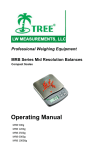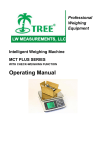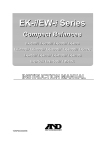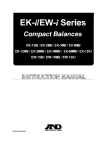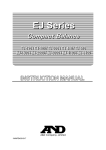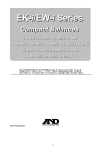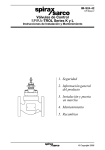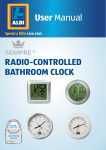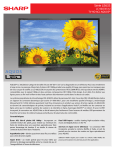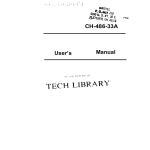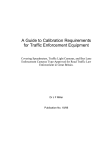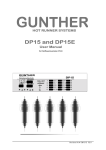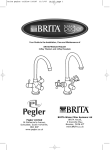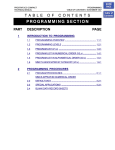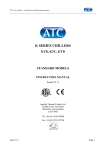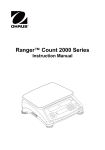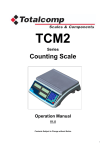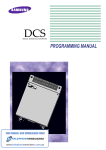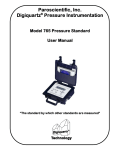Download User Manual - Affordable Scales & Balances
Transcript
Professional Weighing Equipment LCT SERIES intelligent weighing machine LARGE COUNTING SCALE WITH CHECK-WEIGHING FUNCTION Operating Manual 1 Declaration of Conformity Declaration of conformity for apparatus with CE mark We hereby declare that the product to which this declaration refers conforms to the following standards. Electronic scale: LCT Large Counting Scales Imperial version Metric version LCT3 LCT7 LCT16 LCT33 LCT66 LCT110 LCT 1500 LCT 3000 LCT 7500 LCT 15000 LCT 30000 LCT 50000 Mark applied Date: 14. 11. 2012 EU Directive Standards 2004/108/EC EN 61326-1: 2006 Signature: Boon Lim, R & D Manager LW Measurements LLC, 3510 Industrial Drive, Unit H Santa Rosa, CA 95403 2 Identification Customer Service USA LW Measurements LLC, 3510 Industrial Drive, Unit H Santa Rosa, CA 95403 USA Tel: (707) 542-2185 FAX: (707) 542-3285 EUROPE LW Measurements Europe Ltd Chalkwell Park House 700 London Road Westcliff-on-Sea Essex SS0 9HQ United Kingdom Tel: 01702-476700 Fax: 01702-477380 ASIA LW Measurements PTY Ltd Block 1004, Toa Payoh North #03-16 Singapore 318995 Tel: (65) 6458 3438 HP: (65) 8119 3401 http://lwmeasurements.com Refer to our website for information about local customer service centers and details of their addresses. 3 Introduction What you should know about these Operating Instructions: Tree® Professional Weighing Equipment products are simple to operate. Nevertheless, you should read through these operating instructions in their entirety, so that you can make optimum use of the full potential and the diverse possibilities of the weighing machine in your daily work. These operating instructions contain guidance in the form of pictograms and keyboard diagrams, which should help you in finding the required information: For the labelling of potential hazards and advice, please see Safety below. 4 Contents Section Heading 1 Safety 1.1 Representation and symbols 1.2 Safety recommendations 2 Your weighing machine 2.1 Construction and functions 2.1.1 Construction of the weighing machine 2.1.2 Functions of the weighing machine 2.2 Application, conformity, labelling. 2.2.1 Correct use of the weighing machine 2.2.2 Conformity 2.3 Data and parameters 2.3.1 Technical data 3 Getting started with your weighing machine 3.1 3.2 3.3 3.4 3.5 3.6 3.7 4 Unpacking the equipment Scope of delivery Assembling your weighing machine Choice of a suitable location Checking the mains voltage Leveling the weighing machine Calibrating the weighing machine Working with the application menu using the intelligent keypad 4.1 Display messages and key functions 4.1.1 Display messages 4.1.2 Key functions 4.2 Program options 4.2.1 Piece counting 4.2.1.1 Number setting 4.2.1.2 Unit weight setting 4.2.2 Advanced piece counting functions 4.2.2.1 Alarm 4.2.2.2 Low sample warning 4.2.2.3 Unit weight enhancement 4.2.2.4 Low piece weight 5 4.2.2.5 High / low check-weighing with counting 4.2.2.6 Setting weight units 4.2.2.7 Activating the acoustic signal 4.2.2.8 Activating the display backlight 4.2.2.9 Automatic stand-by 4.2.2.10 Memory storage 4.2.2.11 Total weight clear 5 Calibration using an external calibration weight 6 Maintenance and service 7 Transport and storage 7.1 Transportation and shipping 7.2 Storage 6 1 Safety 1.1 Representations and symbols Important instructions, which involve safety, are highlighted with the appropriate mark: 1.2 Safety recommendations When using the weighing equipment in surroundings with increased safety requirements, the corresponding regulations must be observed. The weighing machine may only be used with the power adapter supplied exclusively for use with the weighing machine. Before inserting the power adapter, the user must ensure that the operating voltage stated on the power adapter agrees with the mains voltage. If not, please contact Customer Service at the address above. If the power adapter or its cable is damaged, the weighing machine must immediately be disconnected from the electricity supply (pull out the power adapter). The weighing machine may only be operated from mains electricity supply with a power adapter which is in perfect condition. If there should be any reason to believe that it is no longer possible to operate the weighing machine without danger, the weighing machine is to be immediately unplugged from the electricity supply (pull out power adapter) and secured against inadvertent operation. In carrying out maintenance work, it is essential to follow the recommendations in Chapter 6 Maintenance and service. The weighing machine must not be operated in an area subject to explosion risks. Care must be taken when weighing liquids to ensure that no liquid is spilt into the inside of the weighing machine or into connections on the rear of the equipment or the power adapter. If liquid is spilt on the weighing machine, it must immediately be unplugged from the mains electricity supply (pull out power adapter). The weighing machine may only be operated again after it has first been re-checked by a service technician. These operating instructions must be read by each operator of the equipment and must be available at the workplace at all times. 7 2 Your weighing machine 2.1 Construction and functions 2.1.1 Construction of the weighing machine The weighing machine consists of the weighing machine body (1), the scale-pan (2), the adapter (3) and this operating manual. Figure 2.1 Your weighing machine 2 1 3 8 2.1.2 Functions of the weighing machine The LCT Series are high-quality electronic precision weighing machines designed to function as counting scales and check-weighers with the following specifications a. Imperial weight unit version Model number Capacity Graduation Weighing pan Size LCT 3 3 lb 0.0001lb 227x337mm LCT 7 7 lb 0.0002 lb 227x337mm LCT 16 16 lb 0.0005 lb 227x337mm LCT 33 33 lb 0.001 lb 227x337mm LCT 66 66 lb 0.002 lb 227x337mm LCT 110 110 lb 0.005 lb 227x337mm Net/gross weight 4.2kg / 5.1kg 3 Standard carton: 39 × 39 ×15.5 (cm ) Package Operating Temp. 3 2 Units in one box: 40×40×35 (cm ) 0-40℃ (32-104℉) Rechargeable battery or AC/DC Power source Adapter 10~12V/500mA 9 b. Metric weight unit version Model number Capacity Graduation Weighing pan Size LCT - 1500 1500 g 0.05 g 227x337mm LCT - 3000 3000 g 0.1 g 227x337mm LCT - 7500 7500 g 0.2 g 227x337mm LCT - 15000 15 kg 0.0005 kg 227x337mm LCT - 30000 30 kg 0.001 kg 227x337mm LCT - 50000 50 kg 0.002 kg 227x337mm Net/gross weight 4.2kg / 5.1kg 3 Standard carton: 39 × 39 ×15.5 (cm ) Package Operating Temp. 3 2 Units in one box: 40×40×35 (cm ) 0-40℃ (32-104℉) Rechargeable battery or AC/DC Power source Adapter 10~12V/500mA The built-in versatile weighing programs allow you to use the LCT-Series weighing machines not only for simple weighing but also for carrying out various weighing applications such as, primarily, component counting weighing and the communication function enables the user to document the measurements obtained accurately for record keeping purposes. FEATURES Auto zero tracking Intelligent applications: weight unit conversion, parts counting, high / low check-weighing Low battery indication Large bright backlit LCD Large heavy gauge stainless steel square pan Stability indication Auto calibration Auto back light Unit switching kg or lb Variable kg or lb reference weight calibration software 1.3 million internal resolution 30,000 display resolution 24 bit A/D processor Highest quality sensor used Die cast aluminum sub-support, bottom sensor support and steel thread footing 10 Figure 2.2 Details of your weighing machine Weighing pan Intelligent key pad Bright back-lit display Bubble level Battery compartment cover Battery compartment Leveling feet Mains power connection 11 2.2 Application, conformity 2.2.1 Correct use of the weighing machine The weighing machine may only be used for the weighing of solid-materials and of liquids filled into secure containers. The maximum allowable load of the weighing machine must never be exceeded, otherwise the weighing machine may be damaged. In using the weighing machine in combination with other appliances as well as with appliances produced by other manufacturers, the appropriate regulations for the safe use of the relevant attachments and their application in accordance with instructions must be observed. 2.2.2 Conformity The weighing machine has been manufactured and tested in accordance with the standards and recommendations set out in the declaration of conformity. The power adapter produced for the operation of the weighing machine and intended exclusively for this application, complies with the appropriate electrical protection class. 2.3 Data and parameters 2.3.1 Technical data The following applies to all LCT series weighing machines Power supply: . Input: 110 or 230V AC (+/-15-20%); 50 to 60Hz . Output: 10v DC 500mA Allowable ambient conditions Temperature: 5°C - 40°C Relative humidity: 25% - 85%, non-condensing If you have any questions on the technical data or require detailed technical information on your balance, please contact your technical representative. 12 3 Getting started with your weighing machine 3.1 Unpacking the equipment The machine is delivered in an environmentally-friendly carton, specifically developed for this precision instrument, which provides optimum protection for the balance during transportation. We suggest that you retain the original packaging in order to avoid transportation damage if shipping or transporting the balance and to allow the unit to be stored in the best conditions if it is out of operation for an extended period. In order to avoid damage, attention must be given to the following points when unpacking the balance: Unpack the weighing machine carefully. It is a precision instrument. When outside temperatures are very low, the balance should first be stored for some hours in the unopened transport package in a dry room at normal temperature, so that no condensation settles on the unit when unpacking. Check the weighing machine immediately after unpacking for externally visible damage. If you should find transport damage, please inform your service representative immediately. If the unit is not to be used immediately after purchase but only at a later time, it should be stored in a dry place where fluctuations in temperature are as small as possible (see Chapter 7 .Transport, storage.). Read through these operating instructions, even if you already have prior experience with weighing equipment, before you work with the unit and pay attention to the Safety recommendations (see Chapter 1 .Safety). 3.2 Scope of delivery Inspect delivery for completeness immediately on unpacking all components. Checklist for complete delivery Component delivered present yes / no Weighing unit body Weighing pan Power adapter Operating manual 13 3.3 Assembling your weighing machine The weighing machine is delivered in partly dismantled condition. Assemble the individual components in the following sequence: Place the unit holder in position and add the weighing pan Insert the power adapter cable plug into the socket at the rear of the balance. 3.4 Choice of a suitable location The environment in which your weighing machine is used is very important. Air movement, temperature changes, vibrations, direct sunlight, etc. all influence the performance of high precision weighing machines. Therefore, place your weighing machine on a solid, sturdy surface that is free of air currents, vibration and not in direct sunlight. The surface should not be magnetic and should be located away from doors, windows, heaters, air conditioners and fans. To summarize: Put the weighing machine on a solid, firm and preferably vibration-proof, horizontal base Make sure that the weighing machine cannot be shaken or knocked over Protect from direct solar radiation Avoid drafts and excessive temperature fluctuations 3.5 Checking the mains voltage The following Safety recommendations must be observed when connecting the balance to the mains: The balance may only be operated with the power adapter supplied. Check before connecting the power adapter to the mains supply, that the operating voltage stated on the power adapter agrees with the local mains voltage. If the operating voltage is not the same as the mains voltage, the power adapter must on no account be connected to the mains supply. Contact customer service. 14 3.6 Leveling the weighing machine To function properly, the balance must be precisely horizontal. The balance is fitted with one bubble level. and adjustable feet for level-control, with the aid of which it is possible to compensate for small height differences and / or any unevenness in the surface on which the balance is positioned. The screw feet must be adjusted so that the air bubble is precisely in the center of the sight glass of the bubble level (see Fig. 1) Place the scale horizontally and keep the bubble inside the bubble level aligned with the red circle (See Fig.1). In order to get exact measurements, the balance must again be carefully leveled after each relocation. Fig. 1 Correct leveling with the aid of the bubble level ER 3.7 Calibration of the weighing machine Since the Earth’s gravity is not the same everywhere, each balance must be adjusted to compensate for the gravity differences at each location in accordance with the underlying physical weighing principles. This adjustment process, known as calibration and must be carried out on initial installation and after each subsequent relocation. In order to ensure exact measurements, it is recommended that the balance should be calibrated regularly using a known external calibration weight (see Section 5 below). 15 4 Working with the application menu using the Intelligent Key-Pad 4.1 Display messages and key functions 4.1.1 Display messages: 1. The WEIGHT DISPLAY indicates the gross or net weight on the weighing pan. 2. The UNIT WEIGHT DISPLAY indicates the average or set unit piece weight. 3. TOTAL DISPLAY is the accumulated total pieces on the weighing machine. 4. LOW SAMPLE INDICATOR activates in the display when the sample number is not significant enough to allow accurate counting. 5. LOW PIECE WEIGHT INDICATOR activates in the display when the sample unit weight is not significant enough for accurate counting. 4.1.2 Key Functions: 1. The ZERO key allows the subtraction of multiple container values through the weighing range and is used to set or re-adjust the weighing machine in correct zero position. 2. The TARE allows the user to subtract the container value and returns the display to zero 3. NUMERIC (0-9) KEY is used for setting numeric data for sample number, sample weight or to limit the HI/LO settings. 4. DECIMAL POINT (.) KEY is used to set the decimal position of the sample weight. 5. [SAMPLE/UNIT] KEY is used when setting the counted sample numbers on the weighing pan into weighing machine memory. 6. [UNIT WEIGHT] KEY is used when setting the known unit weight data into the weighing machine in normal operation. 16 7. [CE] KEY is used for canceling the numeric setting data or cancels the previous unit weight data. 8. [QTY/SET] KEY is used for the alternation of changing normal counting and quantity check operation. 9. [M+] MEMORY KEY is used when accumulating the count data; this data is memorized by pressing this key and can be accumulated up to 99 times. 4.2 Program options Besides performing accurate simple weighing, your versatile weighing machine can perform a number of useful applications: piece counting, high / low check-weighing, weight unit conversion. 4.2.1 Piece counting SAMPLE SETTING: There are two sample setting methods: 4.2.1.1 Number setting: When counting pieces with an unknown unit weight Place a pre-counted number of reference samples (for example, 10 units) on the weighing pan, either directly or, using a container (do not forget to tare the container weight first) – The total weight is displayed. Enter the corresponding number of samples (for example, 10 units) using the numeric keys and press the SAMPLE/UNIT key. The average piece weight of the samples shows at UNIT WEIGHT The number of samples shows at TOTAL(pcs); Add in more samples and it will show the total number of pieces. Press CE key to clear any previous setting. Press [CE] key to cancel the previous unit weight and sample setting. 4.2.1.2 Unit weight setting: When counting pieces with a known unit weight Press CE key to clear any previous setting. Press [CE] key to cancel the previous unit weight and sample setting. Place samples on the scale. Key in the average piece weight using the numeric keypad. Press UNIT WEIGHT on the keypad. The total number of pieces will be shown at TOTAL (pcs). Add more units to be counted. Press CE key to clear any previous setting. Press [CE] key to cancel the previous unit weight and sample setting. 17 4.2.2 Advanced piece counting functions 4.2.2.1. Alarm To avoid counting errors, the weighing machine has a useful alarm function to inform the operator of any counting error in case of low sample size or low sample weight. 4.2.2.2 Low sample warning The low sample indicator on the display will activate if the total weight of sample is below the limit value. To rectify, press CE key. Use a larger sample size (more weight), key in sample size on the numeric keypad and press SAMPLE/UNIT. 4.2.2.3 Unit weight enhancement (pieces counting) The scale will automatically adjust and calculate new average unit weight when more samples are slowly placed on the scale. This ensures higher accuracy as samples are now based on larger population size. 4.2.2.4 Low piece weight The Low Piece Weight indicator will turn on if the averaged unit weight or set unit weight is not enough for an accurate counting operation. Operator may use scale even this indicator turn on, but counting error might occur. 4.2.2.5 High / Low check-weighing with counting THE LCT series has a useful check function to give guidance to the operator that the total piece count quantity is below a pre-set lower limit or has reached a pre-set upper limit. This function is designed for packing and other applications. For example, if it is required to count 1000 pieces into each package, the operator can set the lower limit and the upper limit: Press [QTY/SET] to enter quantity alarm menu. Press ZERO to toggle between “CH=ON” and “CH=OFF”. “CH=ON” means quantity alarm function turned on, “CH=OFF” means quantity alarm function turned off. To set the lower and upper count limit, press TARE key to select the high / low limits. For example, “L = 990”, key in 990 through the numeric keypad, then press TARE to switch over to “H=1010”, key in 1010 through the numeric keypad. Press QTY/SET to confirm and return to count mode. If “CH=ON” was set previously , the alarm will produce a tone if samples quantity below 990pcs and a different tone if samples quantity above 1010pcs. 4.2.2.6 Setting weight units Without weight on the platform, press [SAMPLE/UNIT] key to select the unit (kg or lb). 18 4.2.2.7 Activating the acoustic signal When the scale is turned off, press and hold [UNIT WEIGHT] key to turn on the scale, press [QTY/SET] to select activate(b-ON) or inactivate(b-OFF) the function of the beeper. 4.2.2.8 Activating the display backlight When the scale is turned off, press and hold [UNIT WEIGHT] key to turn on the scale, press [ZERO] key to select L-ON, L-AU(for auto) or L-OFF for the backlight function. 4.2.2.9 Automatic stand-by When the scale is turned off, press and hold [UNIT WEIGHT] key to turn on the scale, press [TARE] to select automatic stand-by time. 4.2.2.10 Memory storage Turn on the scale. Select the unit (kg or lb) for the storage of unit weigh by pressing [SAMPLE/UNIT] key. Key in the unit weight value through data 0~9, then press [STORE] to confirm the unit weight. The display will show “c xxx”. Within 2 seconds, press M1, then the third line of the display will show “- - - -”. The memory storage for M1 is complete. Press [CE] to clear the memory, the second line of the display will show 0. Repeat steps above, to store memory values for M2~M9. Press M1 to M9 to recall each pre-stored unit weight from memory. 4.2.2.11 Total weight clear After accumulation was done through [M+], to clear the total pieces, Press [TOTAL] to show total pieces on the third line of the display. Press [MC] to clear the showed total pieces. Press [CE] to confirm. 19 5 Calibration - Using an External Calibration Weight: Calibration is required when the weighing machine is initially installed or if the scale is moved to a substantial distance from the original location. 10 minutes warm up of scale is always needed before calibration. Single segment calibration (recommended): Turn the scale on and then turn it off. Press and hold [ZERO] and then turn on the scale again The LCD will show SCALE on first line, CAL-0 (flashing) on the second line and AD value on the third line. Press [SAMPLE/UNIT] to select calibration unit kg or lb. After the stable A/D value is displayed, press [ZERO], after 2 or 3 seconds, the scale will show 0. Key in calibration weight through numeric keypad and then place the corresponding calibration weight on the weighing pan. ( At least 50% or above of the capacity calibration weight is suggested to get an accurate calibration) Press [ZERO] to confirm once the scale is stable and stable indicator shows on display. Press [ZERO] key, the second line of display will show 00000 and now calibration is finished. Turn off the power, then turn on the power again, place a known weight on the platform to verify if it is accurate. If not, repeat above steps. 20 6 Maintenance and service The weighing machine must be treated carefully and cleaned regularly. It is a precision instrument. For maintenance-work, the balance must be separated from the power supply (remove power adapter plug from socket). Also ensure that the balance cannot be reconnected to the power supply during the work by a third party. Take care during cleaning that no liquid penetrates into the appliance. If liquid is spilt on the balance, the latter must immediately be disconnected from the electricity supply. The balance may only be used again after it has first been checked by a service engineer. The connections on the rear of the appliance and the power adapter may not come into contact with liquids. Regularly dismantle the weighing pan and the weighing pan holder and remove any dirt or dust from under the weighing pan and on the weighing machine housing with a soft brush or a soft, lint-free cloth, moistened with a mild soap solution. The scale and the holder can be cleaned under running water. Take care that both parts are completely dry before they are re-installed on the scale. Never use solvents, acids, alkalis, paint thinners, scouring powders or other aggressive or corrosive chemicals for cleaning, since these substances attack the surfaces of the scale housing and can cause damage. 21 7 Transport, storage 7.1 Transportation and shipping of the weighing machine Your weighing machine is a precision instrument. Treat it carefully. Avoid shaking, severe impacts and vibration during the transportation. Take care that there are no marked temperature fluctuations during the transportation and that the weighing machine does not become damp (condensation). 7.2 Storage of the weighing machine If you would like to take the weighing machine out of service for an extended period, disconnect it from the electricity supply, clean it thoroughly (see Section 6 .Maintenance and servicing.) and store it in a place which meets the following conditions: No violent shaking, no vibrations Minimum temperature fluctuations No direct solar radiation Minimum moisture The weighing machine should preferably be dispatched and transported in the original packaging to avoid transportation damage. The weighing machine should preferably be stored in the original packaging, since this provides optimal protection for the weighing machine. 22






















